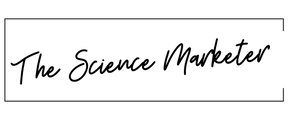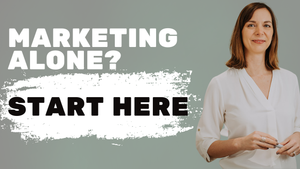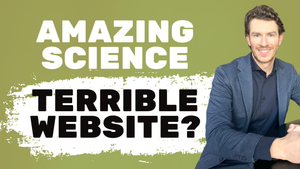Where do you even begin with marketing in biotech?
It’s a question many early-career marketers and startup founders wrestle with, especially in the life sciences, where the stakes are high, the products are complex, and the pressure to deliver results starts on day one. In this conversation, I sat down with Teja Sirec, a fractional marketing director and founder of Biotheia, who specializes in helping life science startups build their marketing from the ground up.
With a background that spans both hands-on execution and strategic leadership, Teja has seen firsthand what it takes to launch effective marketing in early-stage biotech companies.
Whether you're the first marketing hire at a startup or leading a small team with big ambitions, this conversation is packed with guidance you can apply right away.
🎧 Listen to this episode:
🔔 Subscribe to the podcast
🎥 Watch it on YouTube
📖 Or read the interview:
The interview below is based on the transcript of our conversation but has been edited and rearranged for conciseness and clarity.
Teja's background in scientific marketing
Before we dive into today's topics, could you introduce yourself and your company?
Teja Sirec: My name is Teja and I am a fractional marketing director for life science businesses. I operate my company, which is called Biotheia. Basically, what I do is support life science businesses—mostly startups—that need to activate their rapid growth. To do that, they need to build out their marketing function so they can start growing their visibility and commercial pipeline.
These companies usually need senior marketing expertise at a director level, but don’t have the need for such a position full-time. This is where I come in. I help them get going with the strategy. I also assist a little with execution if they don’t have someone in-house yet, while they’re still recruiting. Then I continue supporting the in-house marketers with mentoring and coaching, just so they get that ongoing marketing support over the long term.
The topic of early-days marketing—especially in life sciences companies—is something we see all the time. A lot of people are joining as juniors. They have to build everything, learn everything. You yourself have been an early employee in two different companies. Can you briefly explain those experiences and how it was for you?
T.S.: I worked in two companies over the past few years, and both times I found myself in environments that were just establishing or properly getting started with their marketing function.
My first role, when I transitioned from academia, where I was working as a postdoc, to industry, was as a scientific writer for a business that was manufacturing biochemicals.
I joined at a really interesting time because the business had just established a proper marketing function. We were a team of three, led by a very experienced marketing director. So yeah, we started building from scratch. It was a really, really nice opportunity, and it made me fall in love with scientific marketing. That’s where things started for me.
I also joined quite early in the second company. That was a different business with a different model—a startup commercializing new technology for the characterization and analysis of biological samples.
There, I came into an environment where the business had already worked out some of the marketing foundations. There were several people covering marketing tasks, and also a dedicated marketing person already in place. It was an interesting and very valuable experience because soon after, the company entered a rapid growth phase. We really needed to scale quickly and start generating visible outputs that brought in leads and helped build the commercial pipeline.
After that, I moved into a consulting role. Now, I’m really hoping to offer this experience to other companies because I feel that making the marketing work is not that complicated; you just need to know where to start and what to focus on.
Where to start as a new science marketer
So, talking about where to start—what’s the first thing you recommend to someone who’s alone as a marketer, or working with a small team?
T.S.: Well, I would say, when people come into their marketing role—maybe they are one of the first marketing employees—first of all, get to know the business really well. Start with the product, with the technology. You’re in marketing, but you really need to understand what people are buying and what those unique benefits are, because this is so important for knowing what to talk about.
The second thing, which is really important, is understanding the needs of the business. What does the business need from marketing right now? Oftentimes, this is more complex than just generating leads, because there are a lot of other things that need to happen before you can even get to that point.
And the third thing is to get into the habit of planning things. Even if you start with a small plan, I think that's so important, because a plan sets up what you’ll do. It sets expectations for what the output will be, so the business knows what it will get out of it. And it also helps you set expectations for the budget you need or the support you require.
I think bringing all these things together would really set people up for a solid start.
Establishing marketing processes early on
In one of the LinkedIn posts you shared about this topic, you were talking about building processes early on in a marketing team, and I found this very, very interesting. So, how do you recommend creating those processes, and what exactly are they?
T.S.: The reason why I brought it up was because I know that in early marketing teams, people often find themselves caught between the things they want to do as part of their plan and all the excitement and ideas coming from the team from all directions and all levels. So you kind of want to do both, but then you realize you can’t really.
You need to balance the two, which is why I say that establishing some processes is so beneficial. It helps you, as a marketer, handle the workload, and it also helps set expectations with other people.
And maybe I can give an example—setting up a process for the preparation of application notes. This is usually a really important project because customers want to see some data and proof points, like how your product works, what it can do, etc.
To create an application note, you usually need a few different people working on it. These can be produced in-house, so maybe you need bandwidth from scientists or application scientists to generate the data. In other cases, they could be done in collaboration with customers, so you’d need someone to build that relationship and work with the customer to gather the data, and so on.
What I’m saying is that an application note is a really important marketing asset, but it takes quite some time and many people need to contribute to get it produced and approved. One thing I really recommend is to set up that process early, so you can unfold the production of application notes quickly.
And this becomes even more important as companies grow. At the beginning, there might be just a few stakeholders helping to write or approve these documents. But as the organization grows and the product portfolio expands, there will be many more people who need to have a say. I think that’s where a solid process really makes a difference.
Defining priorities as a new marketing hire
Is there something that companies should absolutely do when they’re starting out their marketing efforts?
T.S.: What I recommend to all companies is to invest a little bit of time in building a strategy. This is the one way to know what marketing should be doing and aiming to achieve. It helps align with the rest of the organization and also helps build some scenarios and expectations around how much it will cost and how long it will take to see results.
What are the criteria you use when working with a startup to help them decide what’s more important to prioritize in their marketing?
T.S.: Something that, for me, has always been a priority in marketing—and something I set for myself as non-negotiable—is execution. Because we need to keep showing up. People consider buying from companies they remember, and they remember what they see repeatedly.
I think this is really important. When you're running a marketing department—or even just functioning in a marketing role at a small company—you wear so many hats. There’s a lot of behind-the-scenes work that’s invisible. Things like cleaning the email list, sorting out the CRM, editing a presentation. These are important, but customers and prospects don’t see them.
What they do see are the valuable assets, the content, the events, so you need to keep showing up with those. That’s what keeps the business going and brings leads in. It’s hard, but for me, execution is absolutely essential—finding the time for it and consistently getting in front of people.
When you say execution, you mean things like sending emails, posting on social media, those kinds of activities where you're showing the company to your audience?
T.S.: Exactly. Email should definitely be a no-brainer. Those people on your email list, you’ve already acquired them. You spent dollars on that, and they want to be reading about what you're doing and how things are progressing. So that’s really low-hanging fruit.
Then there are social media posts, and beyond that, webinars. I’m sure that in every organization, there are people who can talk about the science or the challenges scientists face. So coming up with those ideas and running customer-facing or prospect-facing campaigns is really important.
Building a strategic plan for the long term
Can you describe your process for establishing a strategic plan?
T.S.: The most important thing is understanding the needs and ambitions of the business. When I’m building a strategy or marketing plan for a company, I first spend a day with them, really digging deeply into what their needs are, what their vision is, and where they are now.
I focus on truly understanding their technology—why it’s different, and whether it will make a difference in the future. That’s key. Because if you don’t understand that, your plan and strategy just won’t bring in the right results.
The second part is my own research. I look at the organization from a marketing perspective—what is their marketing readiness when it comes to assets and the capabilities they have in-house. That’s where things start. I do a solid piece of research on them as an organization, and then also on the market, the competitors, and so on.
I also make sure we answer all the key questions that need to be addressed for marketing to be effective. In my experience, there are 11 of them. So we work through a process to ensure we cover all of those.
Do you talk to customers as well to get an idea of why they’re buying this type of product?
T.S.: Yes, I run interviews with customers. I do this to hear their own perspective in their own words, and also to validate the assumptions the company has. Because usually they’ll say, “People think this and that about us and our technology,” and I go back to validate if that’s actually true.
I also explore their overall feedback—what kinds of risks they perceive, what they think is exceptional about the product or service the company is offering, that kind of thing.
Why is it so important to align the marketing plan with the rest of the company?
T.S.: There are two key reasons. The first is that marketing should be delivering things that are useful to the business. The activities and outputs need to directly support what the business is trying to achieve. That’s number one.
The second reason is that a marketing function—or even just a single marketing person—will never be able to deliver everything by themselves. So marketing needs to align with other teams. For example, it should work with sales to make that process efficient and ensure a smooth handover between marketing and sales.
People need to align on how they share information both ways. Marketing should be learning from sales—who are customer-facing—about what’s happening, how conversations are going, and what customers are asking about.
It should also align with scientific teams and product management teams. Having that plan and sharing it across the organization really brings people together and helps align everyone so that things can actually happen.
Measuring early marketing success
Now let's talk about measuring the success of marketing. What indicators are you looking at in the beginning when a company starts its marketing?
T.S.: Small and new businesses really need to start by focusing on building their visibility in the market space. That means people need to know about them and remember them.
Once that happens, people might start researching them, and then maybe buy from them. So when I talk about early indicators, I’m really talking about: how do we know we’re doing a good job in terms of awareness, so that everything else can happen downstream?
One metric I think is extremely valuable is tracking the growth of branded search terms in Google. If that’s growing, if more and more people each month are searching for your company name or your unique technology name, then they are probably looking specifically at you.
I think that’s very, very valuable, because I can confidently say: if those numbers are not growing, then your pipeline won’t be growing either.
And what if this doesn’t happen?
T.S.: I recommend... just doing it. The truth is that people want to learn and research their options and technologies by themselves, before they ever get in touch with a salesperson. So you need to build that authority, both online and, if possible, in live communities, at events, and so on, so that people can find you and research you.
Marketing channels worth investing in early on
Are there any channels where you focus more than others?
T.S.: For small companies, I recommend focusing on the three marketing channels that they own: their website, their email list, and their social accounts.
The first reason is because they’re in control of them, there’s nothing stopping them from using these channels. The second reason is because they’re very effective and powerful.
If they can start building authority on those channels and keep them active, that already brings very solid results. From there, they can start building further.
And what about press relations in the early days of a company?
T.S.: I think PR is good and useful, and I do recommend that small companies aim to publish three to four press releases per year. That’s because it exposes you to a wider audience, which is very helpful.
I do recommend it, but I think the main focus for small businesses should be on building proof points and touchpoints, so people can find real information about the technology.
The great thing is that early adopters and innovators—those who buy the first products—are usually very excited about something new. They love talking about it. So I think there’s a lot of opportunity in preparing application notes with them, running webinars, doing interviews, and so on.
They often want to tell the world they’re making a huge leap in how something is done, analyzed, manufactured, or produced. So for me, that’s where the biggest leverage is in the early days. PR is definitely part of the early-stage marketing strategy, but working with early customers is what I would say is most important and impactful.
Advice for early career marketers
If you could go back to your early days in marketing, what would you do differently?
T.S.: I think I would look for more customer-facing time. So when I was in different marketing roles, I would be joining conferences, for example, which are so valuable for someone from marketing to interact with customers, see how they react to your assets and things that you have on the booth, and see what other companies in your space are doing.
Do you have any resources or books you would like to recommend to someone within science marketing?
T.S.: There is a book that I recommend to everyone who is working towards commercializing a scientific product or service. The book is called Crossing the Chasm by Geoffrey Moore.
Probably everyone has heard about the theory of diffusion of innovation, which says that innovative products are adopted first by innovators—a very small percentage of the population—then by early adopters, and so on. Everyone knows that. But this book is the best resource I’ve found that really dissects and analyzes all these profiles in depth.
As I mentioned, I work a lot with startups that are bringing something innovative to market. And this book really helps you wrap your head around what the messaging should be, and what kind of messaging will land with these different groups. It also helps you understand what kinds of tactics to use, because innovators will be hanging out and looking for information in completely different places than people who are, say, part of the early majority.
This applies directly to buying behaviour. And honestly, I believe it’s not only useful for startups, but also for people working with more mature technologies, because the book also covers those segments in the majority brackets.
So yeah—go read that book. It will be eye-opening.
Thanks to Teja for joining the podcast. If you would like to continue the conversation, you can find Teja on LinkedIn.





